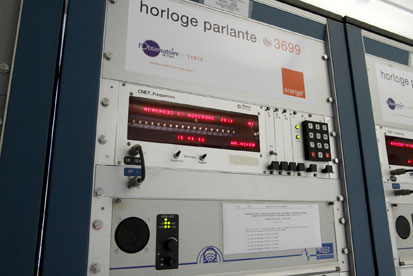A decision taken internationally
The decision to introduce the leap second on June 30th 2015, just before midnight on the international time scale "UTC", is taken at an international level by the « Service de la Rotation de la Terre » (Earth rotation service) of the « Service international de la rotation de la Terre et des systèmes de référence (International Earth Rotation Reference System Service) – IERS ». Housed at the Paris Observatory within the SYRTE department (Observatoire de Paris / CNRS / UPMC / LNE), this entity monitors changes in the orientaton of the Earth and is responsible for predicting and announcing these leap seconds. The last one dates from 2012.
Each country is responsible for the implementation
In France, the Laboratoire national de métrologie et d’essais (LNE-SYRTE ) of the Paris Observatory implements the national time standards, and so is responsible for applying the leap second.

The rotation of the Earth is iregular
The axial rotation of the Earth, responsible for the day-night cycle, slows down over time, essentially because of the gravitational effects of the Moon and the Sun. Furthermore, our planet is perturbed by its internal constituants (core, mantle) and its external ones (atmosphere, oceans) which act on its rotation.
Moreover, the choice of the atomic second was made on the basis of the length of the astronomical second as observed during the second half of the XIXth century, which was significantly shorter than it now.
The interrnational atomic time
To-day, time is measured in a way which does not depend on vagaries of the Earth, thanks to the 400 atomic clocks in various countires around the Earth ; 25 of them are in France. Working in unison, they enable the BIPM to compute the “Temps Universel Coordonné – UTC” (Universal coordinated time). The uncertainty of atomic time is now 10-16.

A difference which must never exceed one second
UTC is so regular and the rotation of the Earth so unpredictable, that the former gets gradually out of step with the day/night time as determined by the rotation of the Earth.
Since this shift could cause difficulties in certain cases, an international agreement signed in 1972 stipulates that the difference between the two time standards must never exceed one second. That is the purpose of the leap seconds : when the difference between UTC and time as determined by terrestrial rotation approaches a second, the two scales are readjusted by the addition of a leap second in UTC.
Since the introduction of this system in 1972, 26 seconds will have been added on the 1st of July next.
The leap second in question
This system constitutes a good compromise to obtain a civil UTC time close to that which corresponds to that given by the rotation of the Earth ; however, it has a number of drawbacks for certain applications, and in particular those related to navigation satellites, telecommunications networks and financial markets. During the last fifteen years, international discussions have been going on to decide whether whether to stop the current procedure of leap seconds.
A meeting organized within the framework of the UIT (Union International des Télécommunications – International Telecommunications Union) will take place in November 2015 in Geneva. Its purpose is to discuss on a scientific level whether or not to maintain the current procedure of introducing leap seconds in order to synchronize UTC with the rotation of the Earth.
If the leap second were abolished, UTC would be decoupled from the rotation of the Earth, and there would no longer be any need to add leap seconds. Kknowing exactly the orientation of the Earth’s axis would nevertheless be of fundamental importance.
